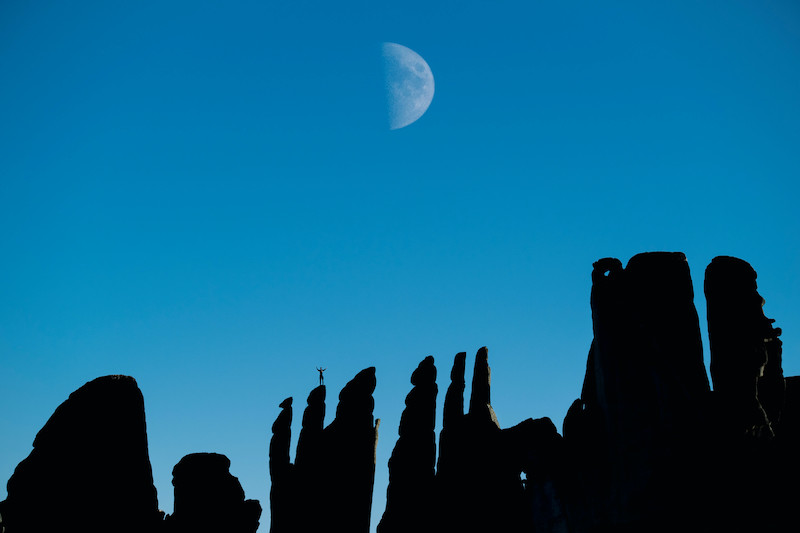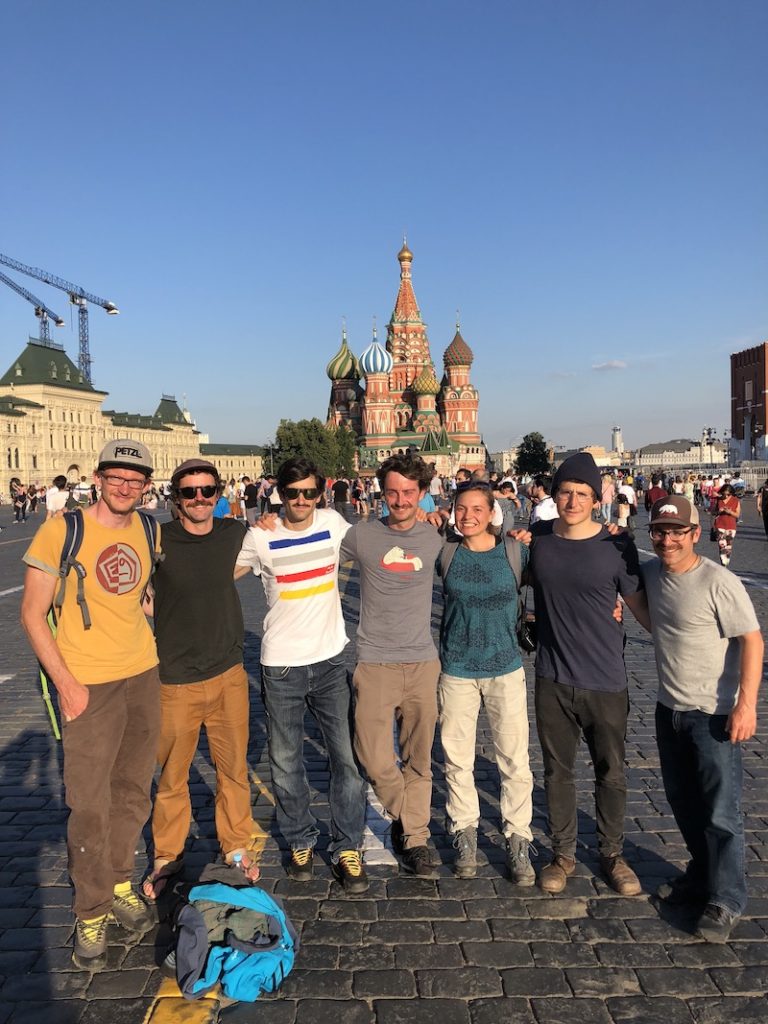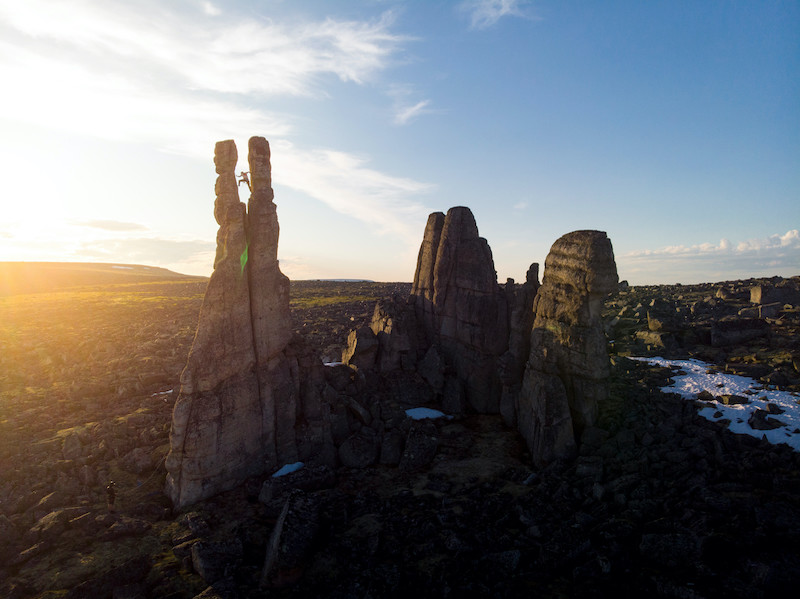When I got a call from my friend Florian Klinger asking if I wanted to join the first climbing expedition to a remote area in Siberia, I didn’t know what I was getting myself into. Of course I said yes.
Being the first climbers to explore a group of Siberian granite towers, called the Granite Cities, presented many challenges and questions—which is precisely what adventure is all about. (Click here to read more about this location’s discovery.)
My role would be to direct and shoot a film documenting our expedition for Red Bull Media House. I enlisted my good friend Dane Henry, also from South Lake Tahoe, to join me as DP.
“Hey Dane, you ever heard of muck boots?” I asked Dane, as I described the 30-day adventure. We both laughed as I described what was, apparently, an essential piece of equipment for this trip: seven-pound rubber galoshes. I could practically feel the blisters forming.
“You think we’ll really need to wear those things?” Dane asked, skeptically. “Don’t you think we can get by in regular approach shoes?”
“Probably, but we’ll bring ‘em just in case,” I said. “I actually have no idea what we’re in for!”


That’s what I love about adventure. It’s about getting yourself into a situation where the outcome is uncertain. Muck boots were only the beginning.
Kilian Fischhuber, an Austrian climber and one of Red Bull’s star athletes, would lead the climbing team, which included Robert Leistner of Germany and Galya Terenteva of Russia.
Elias Holzknecht, a photographer from Germany, would be in charge of shooting stills, running logistics, and helping both the climbing and production teams, including with charging, downloading, audio, and many other critical functions.


A former athlete manager for Red Bull and a good friend I’ve known for years, Florian was the project champion. Once out in the wilderness, his role would be the all-important solar technician. That meant he would bear the weight of carrying our Goal Zero solar panels and chargers, and make sure we were all powered up.
Everything we wanted to bring had to be carried on our backs. That included enough food, clothing, and gear to survive several weeks in a vast Siberian wilderness filled with unknowns. Except for those clunky seven-pound muck boots, everyone pared down their kit to the bare minimum—the lightest, fastest, and smallest gear on earth—all so it could all fit in our backpacks. And that even included the climbers, who only carried just two ropes and a small rack of gear.
It’s funny to be writing this now, two years after our expedition, because I find myself wishing the Nikon Z cameras and Z lenses had been released back in 2018. They would’ve really saved us a bunch of weight and space in our backpacks, while delivering the quality we demanded. Alas, the Z cameras hadn’t yet changed the world (at least my world, since I now shoot them almost exclusively). As we needed to deliver high-quality video and stills, we opted to bring the Nikon D850.



Dane, Elias, and I each carried a D850 camera body. Dane and I pared down to a single set of Nikkor lenses between us: one 70-200mm f/2.8, one 16-35mm f/4, one 50mm prime lens, and one 24-70mm f/2.8. Elias carried his own set of Nikkor glass, which we agreed would function as our backup in case we dropped one of our lenses, and vice versa for Elias. We also carried a few Go Pro cameras with a limited number of mounts for helmets or fixing to cracks.
This kit produced a number of conversations between me and Dane as we weighed the value of an f/1.8 prime vs. an f/1.4. Where could we save weight and what did we absolutely need? Every ounce that went into our packs had to be justified—except for the Russian vodka, of course, which spoke for itself.
As for the muck boots, these unwieldy rubber anchors on our feet ended up being essential—blisters and all. Hiking out through this sopping wet, mosquito-ridden tundra would’ve been impossible without them. We quickly realized that we didn’t even dare leave our tents to go to the bathroom in a pair of sneakers lest they be instantly soaked. I will say that muck boots technology is years behind the technical footwear market, though perhaps that speaks to just how many people find themselves tromping around in Siberia in spring.
One place we could’ve saved weight, perhaps, was with drones. We knew aerial video of these majestic spires was essential. And with only a couple of ropes, and no easy access to any summit, we knew that shooting from ropes would be time-consuming and challenging. We also assumed a high likelihood of crashing our drone, so we doubled down here and ended up carrying two DJI Mavics. Thanks to Dane’s expert flying skills, however, he never ended up crashing even once! So, in hindsight, perhaps we could’ve gotten away with just one drone—and that would’ve only meant more vodka!
It was also interesting to find ourselves recording a bunch of iPhone video as we hiked out to the spires. We carried our phones in our pockets to listen to music or podcasts while hiking through one of the most miserable, mosquito-plagued environments I’ve ever experienced. Having the ability to record quick video clips and spontaneous moments ended up being quite valuable, as a few seconds of that gritty iPhone footy ended up in the final film.
We carried no lighting equipment beyond our headlamps, and only had one super light carbon-fiber Manfrotto tripod with a fluid video head. No boom pole and no long lens.
We brought a mini Zoom recorder, which was about a third the size of the traditional H4n, with wired lav mics, which we hid under shirts for interviews. We also carried a decent shotgun mic mounted cold shoe on the camera and wired into the two track on the Zoom via a 15-foot extension cord.

As this photo of Florian running a Zoom on a stick shows, we improvised heavily and used our creativity to make do with less! But this is what I love about these situations. You’re forced to use your creativity to solve problems. This is how you make the improbable possible.
At the end of the day, the only thing that matters to most clients, no matter who you are, is that you can bring home the goods. I hope when you watch our film, you never feel as if we were booming with sticks, moving too slowly in our muck boots, or carrying just too few lenses. Instead, I hope get immersed in this beautiful world and feel moved by this story of exploration!
It’s been a couple of weeks since our film, TERRA INCOGNITA, premiered on Red Bull TV, and I’ve heard some great feedback from the adventure community. Check it out if you haven’t already seen it. This is one of those adventures that I can still taste two years later. Literally. Last night, Dane came over to my home and we cracked our last bottle of Russian/Siberian vodka to toast the successful release of our film. The booze went down hard, and brought back some wonderful memories of being out in one of the most remote and magical places I’ve ever experienced.
Cheers, and onto the next one!


1 comment
I loved that film. At some point I started thinking, Wait someone’s got to be filming this, but we were so immersed in the climbers and guide that it felt completely organic.
So I particularly enjoy getting this peek behind the scenes.
Comments are closed.